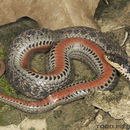en
names in breadcrumbs


The species is considered rare throughout its range. In Michigan it is considered "endangered" and in Indiana it is considered "threatened" (Harding 1997). Because this species likes to make its home around big cities it encounters development and pollution (Rigg 1998).
US Federal List: no special status
CITES: no special status
State of Michigan List: endangered
IUCN Red List of Threatened Species: near threatened
This snake's preferred diet consists mainly of earthworms and slugs (Rigg 1998).
Kirtland's snake can be found in the southeastern most parts of Michigan, most of Ohio, Indiana, Illinois, and north central Kentucky.
Biogeographic Regions: nearctic (Native )
This snake prefers open damp areas like marsh edges and wet fields. This species also has been known to find its way near the outskirts of large cities (Pennsylvania Fish & Boat Commision 1999).
Average lifespan
Status: captivity: 8.4 years.
Kirtland's snakes can grow to roughly around two feet long. They have keeled scales on the upper body that are grayish in color, with two rows of small dark blotches and a row of larger dark blotches along the midline of the snake. They also have an under belly that is reddish with a row of black spots on each margin. The head is dark with a white chin and throat (Pennsylvania Fish & Boat Commission 1999).
Mating occurs in May and the female will give birth to her live young in late summer. The size of the litters usually ranges from 4 to 15 babies. The young snakes will grow rapidly in the first year and reach sexual maturity at the age of two (Harding 1997).
Kirtland's snake (Clonophis kirtlandii) is a threatened or endangered (depending on location) North American species of nonvenomous snake of the subfamily Natricinae, of the family Colubridae.[2] It is the only species in the genus Clonophis.[3]
The specific name, kirtlandii, is in honor of Dr. Jared Potter Kirtland, an American naturalist of the nineteenth century.[4][5] The snake was first identified by Robert Kennicott in 1855. Kennicott sent a specimen to Spencer Fullerton Baird, the assistant secretary of the Smithsonian Institution, who offered to publish a description of the animal in Kennicott's name. Baird suggested Regina kirtlandii as a scientific name, as Kirtland had been a mentor to Kennicott.[6]
Common names for C. kirtlandii include: Cora Kennicott's snake, Kirtland's red snake, Kirtland's water snake, little red snake, Ohio Valley water snake, and spread head.[7]
Kirtland's snake is small and slender. Adults reach a total length (including tail) of 12-18 inches (30–46 cm). It is grayish brown with a double series of large black spots down the back, and alternating smaller spots running down each side.[8] The ventral scales are brick red with a prominent round black spot at each outer end.[9] It has 19 rows of keeled dorsal scales at midbody, and the anal plate is divided.[10]
Kirtland's snake is found in Illinois, Indiana, northern Kentucky, southern Michigan, Ohio, and western Pennsylvania.[9]
The preferred natural habitats of C. kirtlandii are forest, grassland, and wetlands[1] such as swamps and marshes. It is almost always found very close to a water source, even though it is less aquatic than water snakes of the genus Nerodia which share its geographic range.[7] Field studies have shown that populations are found within areas with abundant grass, herbaceous vegetation, and shrubs during the spring season. [11]
The species Clonophis kirtlandii is listed as endangered in Indiana,[12] Michigan, and Pennsylvania.[13] It is listed as threatened in Illinois and Ohio, though current research in Ohio is leaning towards the snake being listed as vulnerable.
Kirtland's snake feeds on primarily earthworms, slugs, minnows, salamanders, frogs and toads.[7] They have also been found to prey on juvenile crayfish, earthworms, slugs, small minnows, and leeches. [14]
When alarmed C. kirtlandii flattens its entire body to a remarkable thinness, and becomes rigid.[15] Kirtland's snake will also coil up into a disc the size of about a quarter in an attempt to hide from potential threats. If this does not succeed, it will then flee instead of fight.
No person on record has ever been bitten by a Kirtland's snake. This species prefers intimidation, hiding, and fleeing rather than any form of fighting.[16]
Kirtland's snake is ovoviviparous. Females give birth in August and September. Brood size varies from 4 to 22. Each newborn is 13–17 cm (5–6¾ in.) in total length and averages 1.4 gm in weight.[7]
Kirtland's snake (Clonophis kirtlandii) is a threatened or endangered (depending on location) North American species of nonvenomous snake of the subfamily Natricinae, of the family Colubridae. It is the only species in the genus Clonophis.